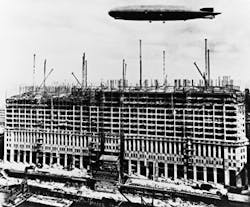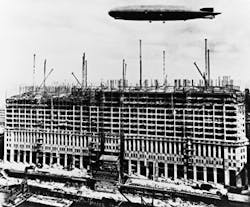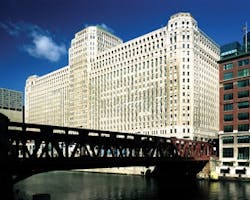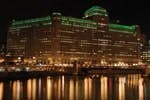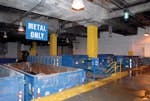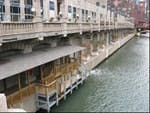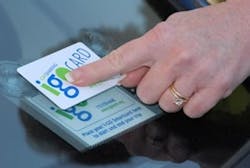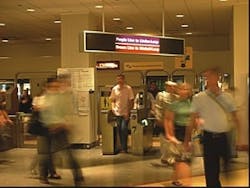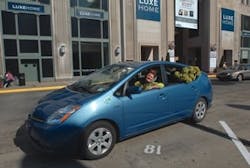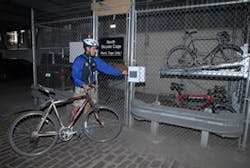Sustainability and Leadership at The Merchandise Mart
Leadership is all about possibilities. Who could have imagined that the world's largest commercial building — built with 29 million bricks, 60,000 tons of steel, 4,000 windows, and 380 miles of wiring — could become a model for sustainability and high performance? Yet, The Merchandise Mart in Chicago, owned by Vornado Realty Trust and managed by Merchandise Mart Properties Inc. (MMPI), has achieved what others have failed to do: In November 2007, the 4.2 million-square-foot property was awarded LEED for Existing Buildings: Version 2.0 (LEED-EB) Silver certification from the U.S. Green Building Council's (USGBC) Leadership in Energy and Environmental Design program.
Built in the 1920s by master retailer Marshall Field & Co., The Merchandise Mart occupies a grand place in Chicago as both a showcase and a resource.
MMPI was no novice to the idea or practice of sustainability. As landlord to office, retail, and wholesale-showroom tenants, as well as producer of 81 tradeshows and consumer events, the firm's commitment to sustainability spans several decades, as evidenced by its building operations/remodeling projects and its pioneering of some of the industry's longest-running green-design programs, educational seminars, and presentations (the most prevalent being NeoCon® World's Trade Fair, the largest conference and exhibition for interior design and facilities management in North America). The decision to go for LEED certification, according to Christopher G. Kennedy, president of MMPI, was prompted both professionally and personally.
"Mart tenants like Haworth, Steelcase, and Herman Miller, all providing environmental leadership, wanted to see it also reflected in their supply chain; as landlord, we were in that supply chain," he says. "In addition, daily visitors to The Mart - designers, architects, etc. who represent the early adopters of the environmental movement - expected us to walk the walk. Chicago has become a strong green advocate, too. We pull a lot of permits and are [in front of] the city on a regular basis: ‘What are you doing about the environment?' has been a constant mantra [from the city]. There was a lot of impetus."
Internally, sustainable building practices were encouraged by owner Vornado Realty Trust; environmentally active members of the Kennedy family (who owned The Merchandise Mart for 50 years before Vornado purchased it in January 1998) had long supported green initiatives, including the construction of a thermal storage system in 1986 that remains cutting edge today. "Because we were aware of some of the environmental challenges, we became aware of the solutions," says Kennedy, noting that the scale of The Mart, both in size and scope, drove a lot of the company's interest and capacity to research opportunities and technologies. He also credits MMPI professionals, particularly The Mart's engineering staff, who were able to substantiate the wisdom of decisions along the way. "We started down this road with no map to guide us; the LEED program helped us find common ground and proved that growth and sustainability are great partners."
A Journey to LEED
1996: MMPI became one of the first major property owners in downtown Chicago to enter into an agreement with the district cooling system (now known as Thermal Chicago Corp.), thus contributing to the national effort to reduce the discharge of ozone-damaging chlorofluorocarbons (CFCs).
2007: The Mart was the first MMPI/Vornado property to become LEED certified.
2007: MMPI announced its objective to have all of its properties become LEED certified.
Getting Started
LEED was developed to define and clarify the term "green building" by establishing a common standard of measurement — a benchmark for the design, construction, and operation of high-performance buildings. To earn LEED certification, a building must meet certain prerequisites and performance criteria within five key areas of environmental health: 1) sustainable site development, 2) water savings, 3) energy efficiency, 4) materials selection, and 5) indoor environmental quality. Projects are awarded Certified, Silver, Gold, or Platinum certification, depending on the number of credits achieved.
Rather than focusing on the construction of efficient and environmentally responsive buildings, as is the basis for much of the LEED series (such as LEED for New Construction [LEED-NC], LEED for Core & Shell [LEED-CS], and LEED for Commercial Interiors [LEED-CI]), LEED-EB helps building owners and managers measure operations, improvements, and maintenance of their facilities on a consistent scale. The certification can be applied to both existing buildings and to projects previously certified under LEED-NC or LEED-CS. The goal: to maximize operational efficiency while minimizing environmental impacts. First for MMPI, though, was to determine if LEED certification was even feasible for such a large, unique building.
With the assistance of the Delta Institute (a Chicago-based nonprofit organization that develops and tests fresh ideas for bringing about sustainable communities), MMPI and The Mart team began their noteworthy endeavor in 2005, with a comprehensive analysis of building practices. No stone was left unturned: Building systems and equipment, construction practices, waste-management procedures, lamp recycling, and more were evaluated. LEED certification was deemed possible, but The Mart team — again — went above and beyond, partly in response to a LEED grant program (from the Department of Commerce and Economic Opportunity) targeted to the for-profit community. In July 2006, during Phase II of the LEED process, MMPI submitted its application to the USGBC for the more challenging Silver certification under LEED-EB.
In earnest, MMPI professionals and the Delta Institute began developing new programs and policies, as well as fine-tuning existing ones, that would reflect their heightened goals for the building. The result, according to Elise Zelechowski, LEED AP and associate director at the Delta Institute, was the preparation of a green-operations guide that covered all of the LEED requirements. "We started implementing that and began practicing LEED on a day-to-day basis, collecting data and synthesizing it," she recalls. "We anticipated having about 1.5 years for that process."
Then, the USGBC announced the relocation of its 2007 Greenbuild conference to Chicago in Fall 2007 — 8 months before The Mart's LEED certification was anticipated to be completed. MMPI seized the opportunity to fast-track its deadlines to synchronize its LEED-recognition reception with the event. "We knew everybody had to really do their part to make this happen," says Zelechowski, praising the efforts of the 400 MMPI employees and 561 Mart tenants. "What an amazing team: The cultural change that needed to happen — and did — was impressive."
The Momentum Builds
That accelerated journey to LEED certification proved both challenging and exciting, says MMPI Senior Vice President Mark Falanga. "The environmental momentum already initiated by market leaders that were showroom tenants in the building was inspiring; their encouragement and interest in our efforts helped make The Mart an even more cohesive ‘community' in this enterprise," he recalls.
Auspiciously, MMPI had been practicing green stewardship for years; many operational policies promoting energy efficiency and operational excellence were already in place. But, some of the first challenges were metering and measuring, notes Lloyd E. Davidson, vice president/general manager at MMPI. "Because we're such a big building, we metered on a much larger block load. It was important to break that down to understand what we were spending on lighting and other mechanical loads, etc."
CO2 sensors in conference rooms were monitored as MMPI staff introduced and adjusted outside air to keep carbon-dioxide levels low, and additional electrical meters recorded usage in more concise zones. An in-place dispatch center focused on finding further efficiencies in scheduling and became the central recorder for equipment tracking. Project Manager Mark J. Bettin, MMPI's vice president-engineering, spearheaded staff and contractor efforts. "In late 2006, we set up a conservation committee, consisting of all the supervisors, Lloyd Davidson, and myself, and we met as a team to figure out what projects to go after," he explains. "Not surprisingly, we found that a lot of our areas already had reasonably efficient fixtures and systems."
Seeking solutions that went beyond "the low-hanging fruit," Bettin tasked the team to look outside the box and pitch ideas from colleagues, staff, and tenants. Once that mindset was embraced, such best practices — both sensible and innovative — were considered and, when practical, implemented. It might now seem obvious that lighting in the building's dock areas didn't need to be on 24/7 (today, split lighting levels and light circuits create a more manageable and economical lighting level in off-hours), but this exploration and evaluation brought such possibilities to the forefront.
Among the most effective tools resulting from MMPI's knowledge-seeking pursuits were the tenants themselves. Marian Jarocki, vice president-assistant property manager at MMPI, was assigned to survey tenants about their energy usage and environmental practices. What could have been an overwhelming chore became a fact-finding mission — one validating that The Mart's LEED-certification agenda was right on target. "Tenants were excited about [the program], excited to be in an innovative building — one that is forward thinking," states Jarocki. "Not only was my time well spent in learning more about our tenants' green activities and educating them about our interests, but it also opened up further communication and feedback — relationships and interaction that continue today."
One public display of this connection is MMPI's creation of "The Green Spot." This visual, changing exhibit on The Merchandise Mart's first floor, which is managed by Jarocki, depicts both a sustainability timeline of green initiatives (including those from showroom partners and the City of Chicago) and a Green Product Gallery and education center that showcase new, innovative, sustainable, and eco-friendly products from Mart tenants. Beyond its value of communicating The Mart's environmental commitment to the public, The Green Spot also earned MMPI an additional point in "Innovations in Upgrades, Operations, & Maintenance" in the LEED-EB certification process.
Among the Sustainable Sites criteria in the USGBC's LEED certification is alternative transportation. The Mart team gained points through providing access to public transportation (CTA), as well as by creating bicycle storage for building occupants. An additional green initiative includes putting into service an I-GO hybrid car-sharing program, which is available 24/7 to Mart staff and tenants.
Taking Action
Point by point, MMPI's interpretation of each segment of the LEED-EB was critical in achieving certification success — a universal accomplishment that's particularly emphasized by MMPI Senior Vice President Myron Maurer. (See the chart for specific LEED points achieved.) "Every department in The Mart was involved in one way or another in our LEED goals, including human resources, operations (electricians, dock personnel, contractors, housekeeping, etc.), accounting/finance, gift, marketing communications, design center, apparel, contract furnishings, tradeshow operations, office and retail, lease administration, legal, property management, and construction services," says Maurer. "We don't view this as a completed project. We have developed the tools; now we use those tools in our day-to-day operations. The Mart [staff] is going to continue to refine and improve our green-building practices. This is a way of life at The Merchandise Mart." Among the many in-place programs are the following ...
Updated construction guidelines. The MMPI construction team updated the guidelines document to make all of the projects at The Mart conform to LEED guidelines. This team is responsible for such projects as selecting sustainable construction materials, filtering return air to maintain indoor air quality, and implementing new standards to reinforce MMPI's commitment to sustainability. (An average yearly basis of 700,000 square feet of space is affected by construction at The Mart, including capital improvements, tradeshow operations, and tenant build-outs.)
Educating vendors. MMPI set up training seminars for all of its contractors, architects, and engineers to both review construction guidelines and train on the new standards. This also ensures that the knowledge base exists and that each contractor fully understands and complies with these standards. To be on the MMPI preferred bidders' list, these service providers have to receive this training. MMPI has also assigned a single project manager to perform random inspections on all projects within the building (with assistance from an independent consultant); documentation, IAQ compliance, and material selections are all reviewed.
Improved recycling. Recognized by Chicago Mayor Richard Daley as one of the city's most successful recycling initiatives, an improved recycling program now includes electronics, batteries, lamps, and construction materials.
Green purchasing. A policy was created for purchasing products with recycled content and those that mitigate poor indoor air quality and pollution of waterways, such as air-friendly paints and nontoxic cleaning products.
Bulk purchasing. As landlord to a large volume of tenants in office, retail, and wholesale-showroom spaces, MMPI is able to offer "community" economies in bulk purchasing supplies and products. As such, the results of its green-purchasing practices are far-reaching and not subject to just MMPI needs.
Recycled paper use. The Mart's tenants and staff now use recycled paper for all business purposes.
Green cleaning. The green-cleaning policy adopted requires that all cleaning products meet high indoor air quality standards per the Green Seal certification program. The Merchandise Mart's Low Environmental Impact Cleaning policy limits the use of potentially hazardous chemical-cleaning agents and requires that all cleaning products: 1) be nontoxic in their undiluted state, 2) consist of ingredients that exhibit biodegradability, and 3) have recyclable primary packaging. Employed and contract cleaners must provide documentation showing specifications on cleaning products used and training on cleaning policies for the building.
Green site maintenance. The Mart now has drought-tolerant plants in all planters to reduce water consumption, and employs an integrated pest-management plan to reduce harmful toxins that pollute air and water.
IAQ management. An IAQ management plan ensures that construction activity in the building does not contribute to poor indoor air quality.
Comprehensive energy management. Now in place is a comprehensive energy-management plan that pilots new technologies and efficiency programs.
Green events. Green-events guidelines now exist for tradeshows to reduce waste and educate visitors.
Natural light. MMPI encourages the use of natural light where possible; in other spaces at The Mart, the company has installed motion sensors on all lights. Exit lights have also been retrofitted to be more energy efficient.
Low- and no-VOC paints. Only low- and no-VOC paints are used at The Mart for construction/remodeling projects and tradeshow build-outs.
Workspeed system. MMPI installed a Workspeed system at The Mart that helps tenants dispatch service requests quickly and effectively. Since it's electronic, less paper is generated and it's more accessible to tenants. A whole category (called "conservation") was created in the system, and energy improvements are documented as they're implemented. In concert, the organization is documenting its training and safety efforts, and has modified its preventive-maintenance program to fit into the LEED program.
Ongoing reporting. LEED certification now dictates how The Mart performs on a day-to-day basis. The USGBC requires quarterly reporting in such areas as staff training, waste management, and recycling statistics.
Lease language. MMPI modified lease language so that, for instance, all tenants comply with new-construction standards.
Transportation initiatives. In addition to the public-transportation access at The Mart, MMPI implemented expanded and protected bicycle storage for The Mart's staff and tenants, and opened up on-site shower facilities for riders. It also put into service an I-GO hybrid car-sharing program (available 24/7) for staff and tenants.
Tenant support and education. MMPI is educating tenants about the green practices in effect, as well as offering further training and support for tenants in pursuit of LEED for Commercial Interiors (LEED-CI) certification in their showrooms.
Future goals. As a continuous improvement process, MMPI's sustainability initiatives are ongoing. Among the areas being evaluated: reducing the quantity of water needed for the building through the installation of more efficient fixtures, optimizing energy efficiency through lighting retrofits, supporting ozone-protection protocols, encouraging renewable and alternative energy sources, purchasing materials with less environmental impact, and eliminating sources of indoor air pollution.
MMPI and Vornado have only touched the surface of a sustainability commitment to their existing building stock. "LEED certification is not only good for the environment, but also makes good business sense. Today's young people entering the workforce want to work in a sustainable environment; [a LEED-certified building] is a competitive advantage for tenants when they try to hire and retain staff," says Kennedy.
Working toward LEED certification is a worthy goal. Attaining LEED-EB in an existing building (particularly one with the magnitude, age, and infrastructure of The Merchandise Mart), however, articulates true leadership and an industry commitment to a sustainable future. It also exemplifies the adage that says "anything is possible." Kennedy notes that the competition to go green will bring out the best in owners and developers in the future.
"Through this leadership, however, our goal is not to be unique," he says. "Our goal is to be one of thousands of buildings."
Linda K. Monroe ([email protected]) is editorial director at Buildings magazine.
